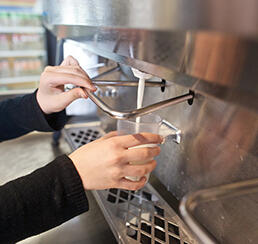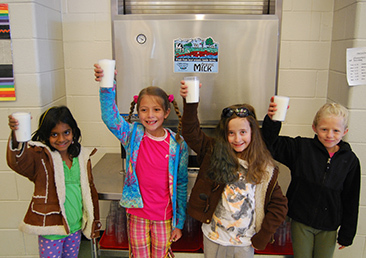
Got (Bulk) Milk?
The Case for Bulk Milk in the School Lunchroom
August 04, 2015
Milk has been a long-time staple in school food. Think back to when you ate school lunch, and you’ll probably remember a small carton of milk sitting on your lunch tray. Today, the USDA guidelines for the National School Lunch and Breakfast Programs require that either low- or non-fat milk be offered with every school lunch or breakfast.
As a result, most schools serve children their milk in either an eight-ounce carton or plastic bottle as they make their way through the lunch line. With more than 30 million kids eating school lunch and more than 13 million eating school breakfast every single day—year after year—those cartons and bottles are really adding up.
The Problem with Bottles and Cartons
At first glance, carton or bottled milk seems convenient. Children get their eight ounces in neat, easily distributed packages. But cartons come with many consequences:
- Waste: Milk cartons and bottles create a lot of waste. The latest EPA waste characterization study indicates that containers and packaging account for 30% of the municipal waste stream, which translates to 75,230,000 tons—the largest category that they track by product type. Before purchasing bulk milk dispensers for six of their schools, Thurston County Schools in Washington contributed more than 5 million half-pint milk cartons to the waste stream each year.
- More waste: Children often don’t finish their eight-ounce milk cartons. Provokare conducted a study on school lunch waste at Murwood Elementary in Walnut Creek, California, that determined students were tossing an annual average of 3,141 unopened milk cartons, and poured out an annual average of 357 gallons of milk, the equivalent of 5,720 cartons.
- Inconvenience: Lunchroom staff has more mess to clean up with cartons and bottles. Custodians at Thurston County Schools reported a 40% reduction in recyclables after they switched to bulk milk. Plus, wax-coated milk cartons aren’t recyclable everywhere, which means the mess that custodians are cleaning up is often heading straight to our landfills.
The Bulk Milk Solution
Bulk milk greatly reduces the amount of waste produced by lunchrooms across the country, and also encourages kids to consume more dairy since the dispensers have better temperature retention than the individually packaged cartons, meaning the milk remains icy cold and more appealing.
“Dispenser milk is always cold and delicious, so kids drink more,” says Chef Ann Cooper, founder of the Chef Ann Foundation and director of food services at Boulder Valley School District in Colorado. Having implemented milk dispensers in her lunchrooms years ago, Chef Ann reports that “the self-serve component helps alleviate waste,” making bulk milk a “win-win” for school districts.


The Bulk Milk Solution
Bulk milk greatly reduces the amount of waste produced by lunchrooms across the country, and also encourages kids to consume more dairy since the dispensers have better temperature retention than the individually packaged cartons, meaning the milk remains icy cold and more appealing.
“Dispenser milk is always cold and delicious, so kids drink more,” says Chef Ann Cooper, founder of the Chef Ann Foundation and director of food services at Boulder Valley School District in Colorado. Having implemented milk dispensers in her lunchrooms years ago, Chef Ann reports that “the self-serve component helps alleviate waste,” making bulk milk a “win-win” for school districts.
More Benefits of Bulk Milk
- Paired with reusable cups, bulk milk produces much less waste than cartons, which is better for the environment. Milk is stored in five-gallon bags (replacing 80 bottles or cartons), which also takes up less space in the cooler than boxes of milk bottles or cartons.
- Custodians deal with less trash and recyclables, and some school administrators even suggest that spills are reduced when children drink milk in cups and not cartons.
- School food staff at Olympia Schools reported that students tend to take what they drink and drink what they take from bulk milk dispensers, which means that less milk is being thrown out, reducing both waste and costs.
The bulk milk method is only used in a handful of districts that we are aware of, but it is a common feature in many institutional service environments like colleges and hospitals. The production of bulk milk units is common in the dairy industry, and is an option that is both cost effective and environmentally friendly.
For school districts looking to cut waste and serve convenient, tastier dairy, we ask, “Got bulk milk?”
This post was sponsored by Organic Valley, who is committed to promoting environmental sustainability and food education. Chef Ann Foundation is proud to partner with Organic Valley to further our work of educating children and school districts about good food choices.
Interested in reading more helpful articles from us? Sign-up for our newsletter in the footer below.







